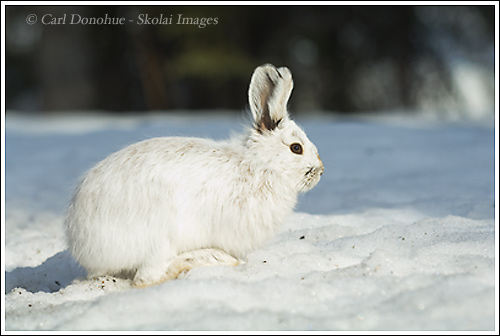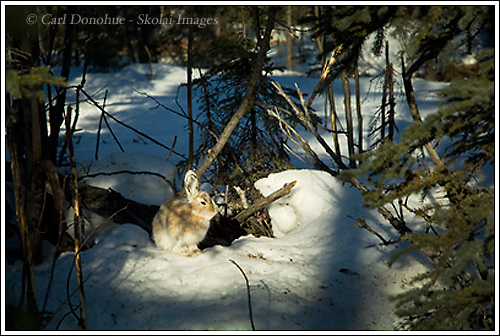
Hey Folks,
Here’s a look at a Snowshoe hare (lepus americanus) just as it starts to pelage and change to its summer coat, and below, a look at another hare further along in the process. I like to try to photograph animals in the various stages of their phenology, and also to try some different kinds of compositions – the one below showing a little more of the forest this snowshoe hare lives in, and what they might do this time of year; sit in the morning sun and catch some rays after a long, cold winter. Speaking from experience, I can assure you the sun feels mighty good as the days started to finally get longer.
One thing you’ll notice here, if you look closely, is the black tips of the ears. Even in the middle of winter, the snowshoe hare ears keep those little black tips, though I’ve never understood why; in some places further south, like Oregon and Washington, Snowshoe hares can stay the dark summer brown all year long. You also get a little more of a look at the size of those big back feet here.
Snowshoe hares have a pretty tough winter, and browse mostly on willow and birch. but also aspen and poplar bark, some spruce, and whatever other greenery they can find. Dwarf birch seems to be their favorite. It’s can be pretty impressive to see the forest after a winter of heavy browsing by an intensive snowshoe hare population, lots of small trees and shrubs stripped bare; you can see some of the browsed vegetation in the photo below, and the culprit at hand.

Cheers
Carl
Hey Carl,
Been a long time since I posted any comments. Hope you are well!
These snowshoe hares are little cute creatures. 3 years ago when I was in Denali I did manage to get a shot of one of these, but s/he had a sort of greyish brown coat. I never knew that they change color to almost total white during the winter. Nice capture there.
Do these change their coat color as a process of natural camouflage? Just curious.
I’ve gotta look at some of your other shots. Till I saw the date on your post I didn’t realize that I had been away for that long!
Happy springing!!
Sai
Are you interested in becoming a nature photographer for love of nature and the art or for money? If it’s the latter, don’t bother. You should do photography because you enjoy it, not by how much money you can make.